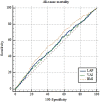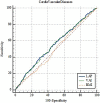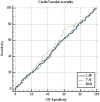Lipid accumulation product and visceral adiposity index for incidence of cardiovascular diseases and mortality; results from 13 years follow-up in Isfahan cohort study
- PMID: 38264005
- PMCID: PMC10804326
- DOI: 10.1002/osp4.713
Lipid accumulation product and visceral adiposity index for incidence of cardiovascular diseases and mortality; results from 13 years follow-up in Isfahan cohort study
Abstract
Background: /Aims: Visceral adiposity index (VAI) and lipid accumulation product (LAP) are novel anthropometric indices that have shown an association with metabolic syndrome; however, limited data are available regarding the predictive performance of these indices for the incidence of cardiovascular diseases (CVD) and mortality.
Methods: This study was performed on the data retrieved from Isfahan Cohort Study (ICS). ICS is an ongoing population-based cohort study conducted in 3 counties in central Iran. Pearson correlation analysis was performed between LAP, VAI, and metabolic parameters. Cox regression analysis and receiver operative characteristics (ROC) curve analysis were performed in order to evaluate the ability of VAI and LAP for the incidence of CVD, CVD-associated mortality, and all-cause mortality. We further compared the predictive performance of VAI and LAP with body mass index (BMI).
Results: LAP and VAI were significantly correlated with all metabolic variables, including blood pressure, fasting blood glucose, and lipid profile components. Univariate regression analysis indicated a significant association between LAP and VAI and CVD incidence. In multivariate analysis, only VAI was significantly associated with CVD incidence. Regarding CVD mortality, only VAI in the multivariate analysis revealed a significant association. Interestingly, Both VAI and LAP were negatively associated with all-cause mortality. ROC curve analysis indicated the superior performance of LAP and VAI for predicting CVD incidence compared to BMI; however, BMI was better in predicting all-cause mortality.
Conclusion: Compared to BMI, LAP and VAI have better predictive performance for the incidence of CVD. In contrast, BMI was superior to VAI and LAP in the prediction of all-cause mortality.
Keywords: abdominal obesity; anthropometry; cardiovascular diseases; mortality.
© 2023 The Authors. Obesity Science & Practice published by World Obesity and The Obesity Society and John Wiley & Sons Ltd.
Conflict of interest statement
All authors declare no conflicts of interest.
Figures



Similar articles
-
Association of novel visceral obesity indices with 10-year risk of major cardiovascular events in patients with type 2 diabetes mellitus.J Egypt Public Health Assoc. 2025 May 30;100(1):12. doi: 10.1186/s42506-025-00188-w. J Egypt Public Health Assoc. 2025. PMID: 40445502 Free PMC article.
-
Evaluation of the novel three lipid indices for predicting five- and ten-year incidence of cardiovascular disease: findings from Kerman coronary artery disease risk factors study (KERCADRS).Lipids Health Dis. 2023 Oct 5;22(1):169. doi: 10.1186/s12944-023-01932-x. Lipids Health Dis. 2023. PMID: 37798657 Free PMC article.
-
The visceral adiposity index and lipid accumulation product as predictors of cardiovascular events in normal weight subjects.Clin Nutr ESPEN. 2022 Dec;52:190-197. doi: 10.1016/j.clnesp.2022.10.015. Epub 2022 Nov 17. Clin Nutr ESPEN. 2022. PMID: 36513453
-
Accuracy of novel anthropometric indices for assessing the risk for progression of prediabetes to diabetes; 13 years of results from Isfahan Cohort Study.Arch Endocrinol Metab. 2024 Oct 1;68:e230269. doi: 10.20945/2359-4292-2023-0269. eCollection 2024. Arch Endocrinol Metab. 2024. PMID: 39420936 Free PMC article.
-
Lipid accumulation product and visceral adiposity index as independent predictors of long-term survival after gastric cancer immunotherapy.BMC Cancer. 2025 Jun 5;25(1):1009. doi: 10.1186/s12885-025-14411-6. BMC Cancer. 2025. PMID: 40474106 Free PMC article.
Cited by
-
Association of insulin resistance-related indicators with cardiovascular disease in Chinese people with different glycemic states.Front Endocrinol (Lausanne). 2025 Apr 17;16:1515559. doi: 10.3389/fendo.2025.1515559. eCollection 2025. Front Endocrinol (Lausanne). 2025. PMID: 40313486 Free PMC article.
-
Associations of Cardiometabolic Indices With Peptides Related to Hypertensive Disorders of Pregnancy in Adult Men.Cureus. 2024 Jun 12;16(6):e62232. doi: 10.7759/cureus.62232. eCollection 2024 Jun. Cureus. 2024. PMID: 39006734 Free PMC article.
-
Association of visceral adiposity index (VAI) with prognosis in patients with metabolic syndrome and heart failure with reduced ejection fraction.BMC Cardiovasc Disord. 2025 Mar 7;25(1):160. doi: 10.1186/s12872-025-04591-1. BMC Cardiovasc Disord. 2025. PMID: 40055587 Free PMC article.
-
Visceral adiposity index, premature mortality, and life expectancy in US adults.Lipids Health Dis. 2025 Apr 15;24(1):139. doi: 10.1186/s12944-025-02560-3. Lipids Health Dis. 2025. PMID: 40234930 Free PMC article.
-
Association of novel visceral obesity indices with 10-year risk of major cardiovascular events in patients with type 2 diabetes mellitus.J Egypt Public Health Assoc. 2025 May 30;100(1):12. doi: 10.1186/s42506-025-00188-w. J Egypt Public Health Assoc. 2025. PMID: 40445502 Free PMC article.
References
LinkOut - more resources
Full Text Sources
Research Materials
